
Jumma Aur Arfa Kay Din Kay Fazail
TAG: Eid al-Adha
Prophets Ibrahim And Ismail Exemplify Sacrifice
Hajj and Eid Al-Adha take us back in history to the time of a 97-year-old (approximately) man being asked to take the life of a 13-year-old (approximately) boy. Who is that man? And who is that boy? And who is the one who is making this command? If we know who the three points in this equation are, we would have a better perspective on life and on what life is all about.
The man who was asked at 97 years of age to take away the life of a 13-year-old boy is none other than Prophet Ibrahim (peace be upon him), the father of prophets and messengers. And the 13-year-old boy whose life Prophet Ibrahim was asked to take away is none other than his own son. But when the boy reached the age when he was able to run and play around his father, Ibrahim went to him and said, “My darling son, I saw in my dream that I was sacrificing you.” We all know that the dreams of prophets and messengers are forms of revelation from Allah Almighty. So it was the truth.
Now, who was the one who gave that command? It was none other than Allah. The One Who created life had asked Ibrahim to take away the life of his son. And we know that His decree was that Ismail’s life would not be taken away, but it was a lesson for humanity to understand what life is all about.
Allah wanted Ibrahim to teach humanity a lesson. Thus we have to understand this lesson and reflect upon it. There are two things that Allah Almighty made beautiful in this life. These two things are mentioned in the Qur’an more than once: “Wealth and children are the ornaments of the life of this world ….” (18:46)
That is it! Wealth and children make life beautiful. Look what happened! Allah Almighty chose one individual to sacrifice one of these two things, and He did not ask any other human being to do the same. One individual became an Ummah. Why? Because Ibrahim passed the test of a whole Ummah. He was asked to sacrifice one of the two things that are ornaments of life, and all of us have been asked to sacrifice the second. So because of that, he indeed, is an Ummah in the same way that we are an Ummah. He truly deserves that title: “Verily, Ibrahim (Abraham) was an Ummah, obedient to Allah, Hanif…” (16:120)
This is the spirit of Eid Al-Adha. We have to sacrifice, brothers and sisters, when we are called upon to sacrifice what we really like to keep: “By no means shall you attain Al-Birr (piety and righteousness, here it means Allah’s reward, i.e. Paradise) unless you spend (in Allah’s cause) of that which you love; and whatever of good you spend, Allah knows it well.” (3:92)
If you have a lot of money and you take a thousand dollars and give it, this would not be birr. Birr is to have two dollars and to give one of the dollars away although you need the two dollars and would like to keep them for essentials.
This is a sacrifice. Sacrifice is to do something that is difficult to do. This is sacrifice. It is not a sacrifice to do an easy thing and then to claim at the surface as if you did a lot. No, only Allah Almighty knows what sacrifice is all about.
Eiden Ka Bayan
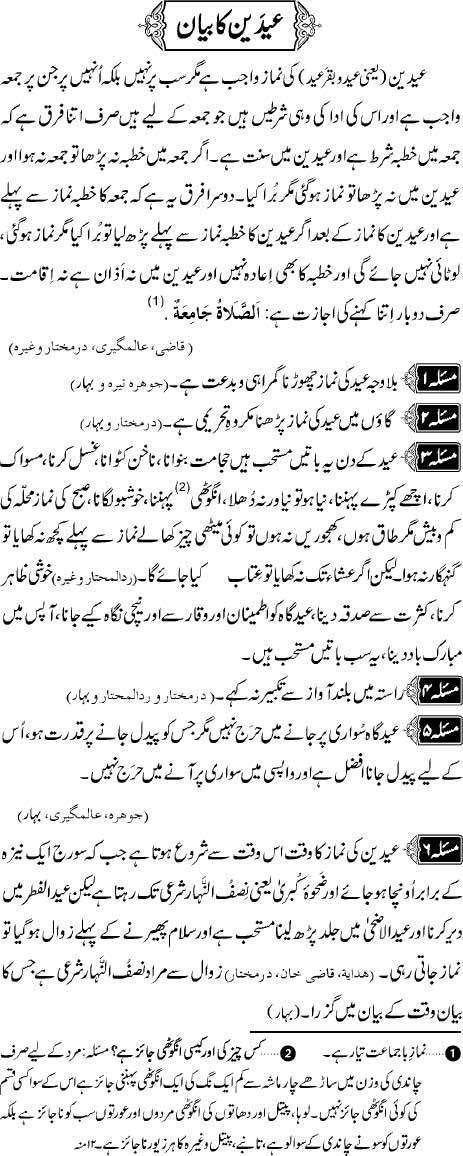
Eiden Ka Bayan
Namaz e Eid Ka Tariqa
Namaz e Eid Ka Tariqa
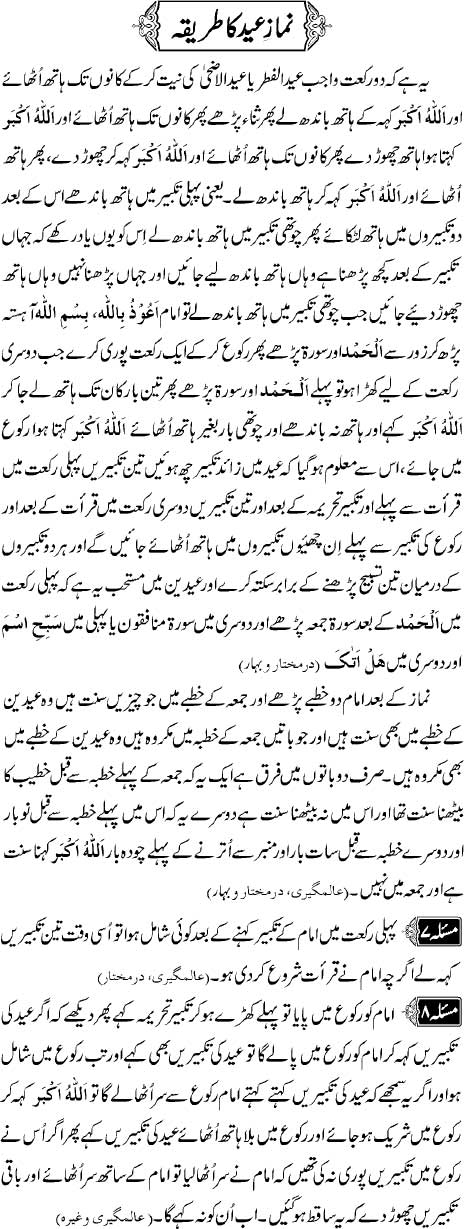
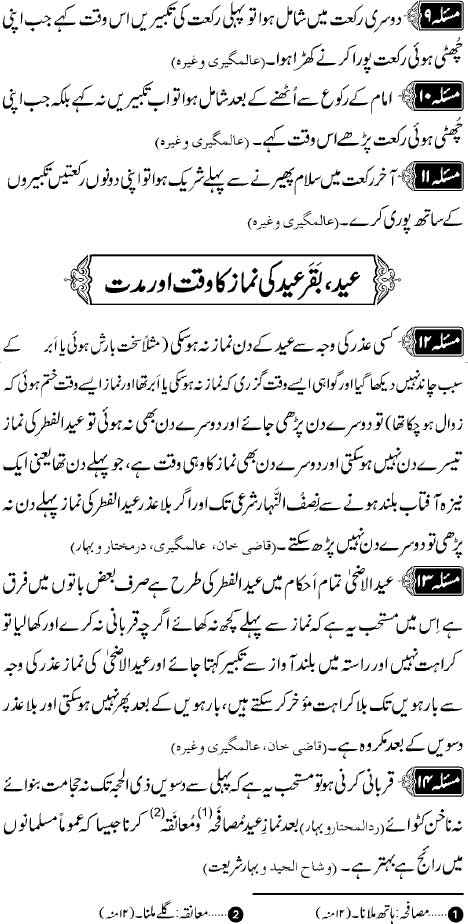
Namaz e Eid Ka Tariqa
Takbeer Tashreeq Kya Ha?
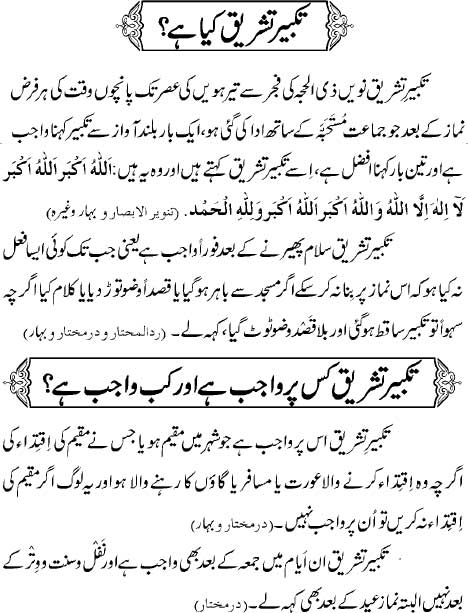
Qurbani Kay Ahkam
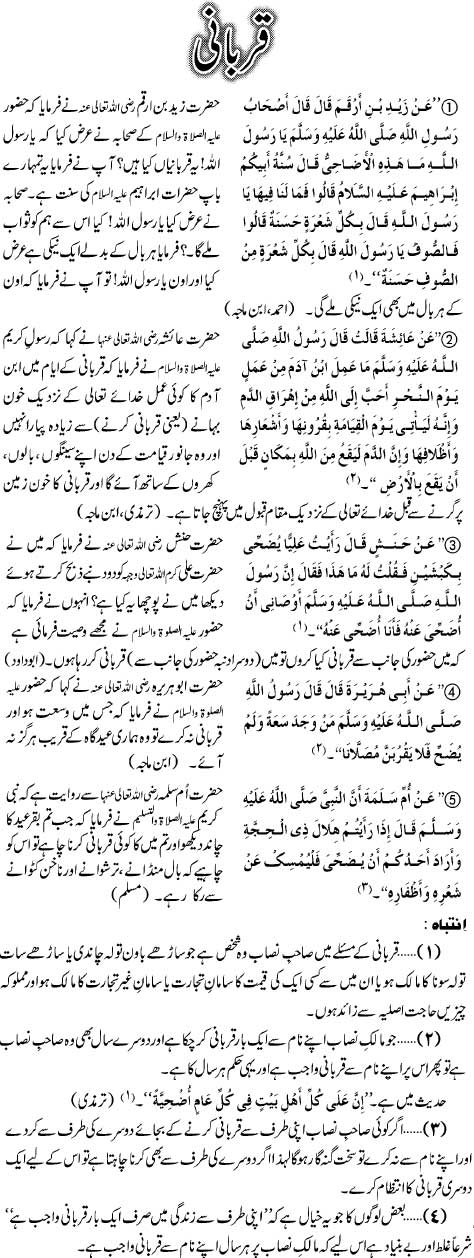
Eid ul-Fitr Aur Eid Al-Adha
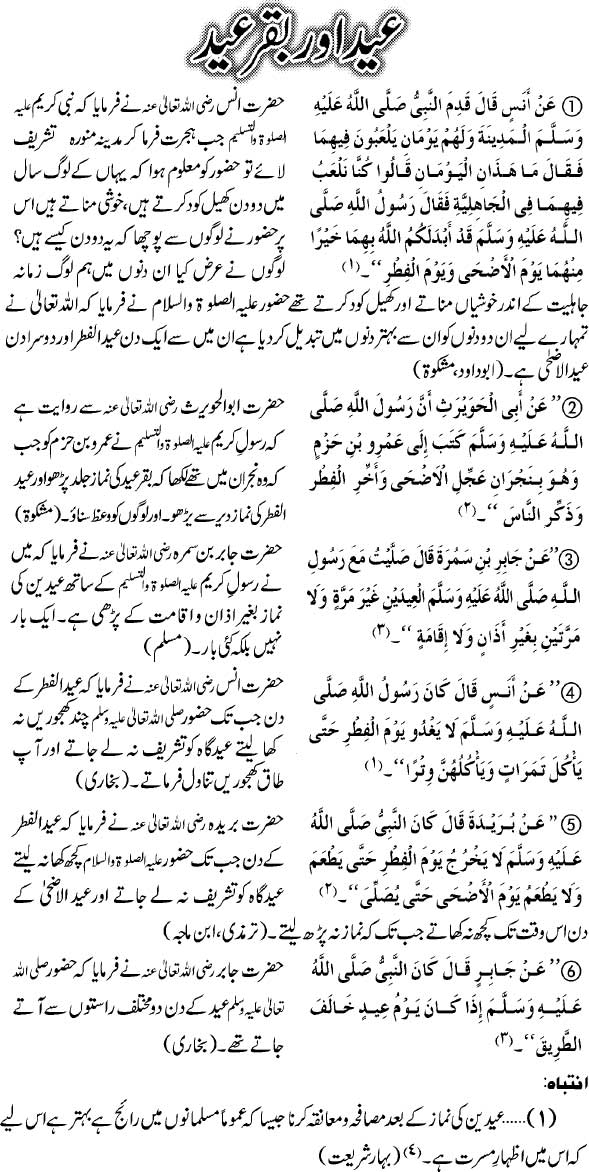
Eid al-Adha
It is a road-map to success and a reminder of the standard of excellence, great devotions and triumph of high achievements. It charts the direction in the battle of life for those who does actually strive to do deeds and reach for their goal, their prize. The promised prize that no human being could imagine the joys kept hidden as reward for all that they did, await at the end of the road. The eye has seen not, nor the ear heard, nor does the heart of man ever conceive.
Abraham was certainly a model of faith for the people, obedient to Allah and upright. Allah pay back people who do good and this event is one of the proofs of Allah mercy thus indeed do doers of goods rewarded.
A great event when Abraham and his son Ishmael passed the trial successfully. We offer remembrance of Allah’s blessings, celebrate His name and offer the eid salaat to give thanks for sending us guidance and map to tread through the life’s path.
There should be no room for emotions which go against the commands and prohibitions of Allah. Eid teach us to trust that He shall not give us more than what we can bear. He will either shield us from suffering or will give us unfailing strength to bear it. Was it not said to ‘follow My Guidance, no fear shall be on them, neither shall they sorrow’ Certainly Allah knows best and was best witness when Ishmael said:
“O my father! Tie my hands and legs so that I do not struggle.
Put a blindfold over your eyes so that you do not have to see me die
And tighten your cloak so that my mother does not see my blood splattered on your clothes. Make your knife sharp so that you can do your job quickly. That way I will feel no pain.”
Peace be upon Ibrahim. Indeed this was a clear trial.
Eid al-Adha is a light that shine our way near and far,
The love of Ibrahim for Allah was true, tested by fire to stay forever.
Devotion so endless, will always light the way.
It is a light that could shine the difficult ways in times of trials. We can do more than just lament the flaws of the Muslim Ummah, for a better world to live and make the word of Allah dominant in the world. If we can all sacrifice what we love most for Love of Allah as Ibrahim did to his son Ishmael. Only then we will know the power and wisdom of Eid al-Adha and deserve what Allah has promised, to grant succession and security after fear. If we can stand strong in the middle of trials and hardships, know that surely Allah help will find way to shine through.
This event also reminds us of one of the pillar of Islam, the hajj. It manifests a unique unity, dispelling all kinds of differences. Muslims from all corners of the world, wearing the same dress, respond to the call of Hajj in one voice and language: LABBAIK ALLA HUMMA LABBAIK (Here I am here I am O lord!).
Hajj is a great congress that gives an opportunity to Muslims all over the world to meet annually. The time, venue and even the invitation has been set by the One True God when Allah, the Almighty, said to Ibrahim:
“You call, and I will convey your call.”
How To Do Eid-ul-Adha Prayer
Eid is a special occasions and one of the things which makes it so is the Eid-ul-Adha congregational prayer.
Since this prayer comes only once a year, there is often confusion about how to perform this prayer. Here is how to do it:
In general, when praying any Salah, always follow the Imam in prayer. Do not make your movements (i.e. bowing, prostrating, etc.) before he does or different from him.
Eid prayer consists of two units (Rakat in Arabic, singular is Raka). The main difference in the way this prayer and any other prayer of two Rakat is performed is the number of Takbirs that are done.
Takbirs is an the Arabic word referring to when “Allahu Akbar” is said and the hands are raised to the ears.
Step 1: Make an intention of doing two Rakat behind the Imam for Eid prayer along with six additional Takbirs.
The First Raka
Step 2: After the Imam has said “Allahu Akbar” the first time, you should raise your hands and follow. This is the first Takbir of the prayer.
Step 3: There will be 3 Takbirs before the Imam starts reciting Quran. Each time the Imam says “Allahu Akbar”, you should follow by raising your hands, then putting them on your sides.
After the third Takbir, the Imam will begin reciting the Quran. At that point, you should put your hands below the navel (or on your chest), with your right hand on top of the left.
Step 4: Listen to the recitation of the Holy Quran. The Imam will recite Surah Al Fatiha (the first Surah of the Quran) and then another Surah.
Step 5: When the Imam says “Allahu Akbar” go into Ruku (the bowing position).
Step 6: Stand up straight when he says Sami Allahu liman Hamidah (Allah hears those who praise Him), and say “Rabbana lakal Hamd” (our Lord praise be to You) in a low voice.
Step 7: When the Imam says “Allahu Akbar” go into Sujud (prostration). You will do two prostrations as in normal prayer.
The Second Raka
Step 8: The Imam will first recite from the Holy Quran (first Surah Al Fatiha and another Surah.
Step 9: After the recitation, before going into Ruku, there will be 3 Takbirs. Follow the Imam. Raise your hands after each “Allahu Akbar”. After the third Takbir, go into Ruku (the bowing position).
Step 10: Stand up straight when the Imam says Sami Allah huliman Hamidah, and say “Rabbana lakal Hamd” in a low voice.
Step 11: When the Imam says “Allahu Akbar” go into Sujud. You will do two prostrations.
Step 12: After this, you sit for the complete Tashshahud.
Step 13: After the Imam ends the prayer by turning to his face to the right first and saying “Assalamu alaikum wa Rahmatullah” and then to his left and doing the same, you should follow.
Step 14: Do not get up right away. The Imam will give a short Khutbah (speech). Please stay still and listen. It is recommended to do so.
Falsafa-e-Qurbani


